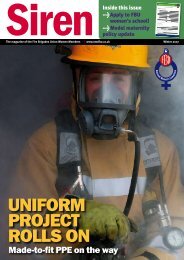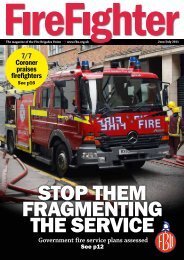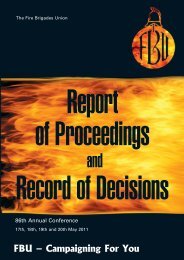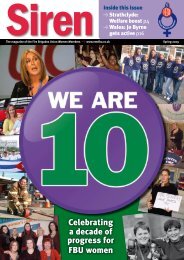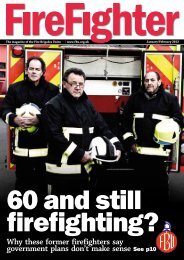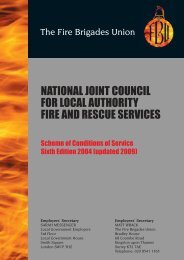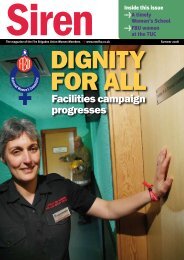Report - Fire Brigades Union
Report - Fire Brigades Union
Report - Fire Brigades Union
You also want an ePaper? Increase the reach of your titles
YUMPU automatically turns print PDFs into web optimized ePapers that Google loves.
SECTION B — FIRE AND RESCUE SERVICE POLICY<br />
●<br />
●<br />
the representative bodies. This would bring further<br />
local accountability as well as specific expertise to the<br />
governance arrangements;<br />
There are alternative mechanisms for appointing<br />
members of the governing body that are worthy of<br />
consideration. Such systems could include directly<br />
elected bodies or commissioners. Consideration should<br />
also be given to sharing the structures of this with the<br />
Government’s plans for elected Police commissioners.<br />
Indeed, one might suggest that there should be one<br />
local Commissioner covering the entire area of Public<br />
Protection within a locality, not only are the<br />
responsibilities best co-ordinated together but it would<br />
also demonstrate good and responsible use of public<br />
funds;<br />
Citizen panels are a mechanism available to assist all<br />
forms of governing body structures.<br />
Delivery<br />
●<br />
●<br />
●<br />
The potential role of community volunteers in the<br />
delivery of prevention, protection and response<br />
services must be taken forward;<br />
It is recommended that a local volunteer station model<br />
is developed to respond to community wishes similar<br />
to those successfully used elsewhere in the UK;<br />
Greater collaboration in delivery between services<br />
could be achieved by placing a selected number of<br />
organisations that all deal with safety related matters<br />
within the same governance arrangements. The three<br />
blue-light services are an example, but this could be<br />
expanded to cover all the preventative or legislative<br />
enforcement areas. Other models put forward as<br />
options elsewhere within <strong>Fire</strong> Futures propose placing<br />
a selected number of organisations that all deal with<br />
safety related matters within the same governance<br />
arrangements.<br />
4. TRANSPARENCY AND ASSURANCE<br />
The objective is for information about local institutions and<br />
public services to be transparent to people to make them<br />
more democratically accountable. By publishing<br />
information, taxpayers and users will be able to judge<br />
whether productivity is improving and government is<br />
delivering on its ambitions for better services for less<br />
money.<br />
There are four key types of information on public services<br />
where the Coalition Government has indicated it would like<br />
to see transparency which supports the objectives of<br />
localism:<br />
●<br />
●<br />
●<br />
●<br />
Financial data (eg costs and expenditure, salaries,<br />
organograms)<br />
Performance information (eg impact/outcome<br />
indicators)<br />
Service information (eg library opening hours)<br />
Decision making (eg meeting agenda and minutes,<br />
planning and licensing applications).<br />
Assurance processes need to support the provision of<br />
information by FRAs to their service users on the quality<br />
and value for money of their services. It also needs to<br />
provide for appropriate assurance about FRS performance,<br />
both locally and nationally in a decentralised environment.<br />
There is a risk that some FRAs retrench into silo-based<br />
thinking focussed exclusively on the blue-light operational<br />
aspects of service delivery. Appropriate transparency and<br />
assurance measures covering the range of FRS functions<br />
will help provide external challenge to help authorities avoid<br />
this risk and provide communities with the tools and<br />
information to hold authorities to account for the services<br />
they provide.<br />
The Localism and Accountability workstream of the <strong>Fire</strong><br />
Futures review, in considering an appropriate new model to<br />
provide assurance and transparency, has built upon the<br />
existing work undertaken by the LGA and CFOA on a<br />
sector-led framework. This model would need to meet the<br />
objectives of:<br />
●<br />
●<br />
Helping equip citizens with the tools and information to<br />
hold local services to account in terms of delivery of<br />
outcomes and value for money; and<br />
Within a <strong>Fire</strong> and Rescue context to be able to provide,<br />
to the public and ministers, confidence about the<br />
Service’s ongoing capability to respond to emergencies<br />
beyond the local level, to deliver national resilience and<br />
interoperability across FRAs and with other public<br />
services.<br />
The proposed model builds on existing peer support<br />
structures to provide effective assistance and assurance<br />
and to maintain the positive performance trajectory of the<br />
FRS. This reflects shared principles of what a sector-led<br />
improvement framework should look like in recent<br />
iterations of the CFOA sector led improvement framework<br />
and the LG Group’s consultation documents Setting the<br />
Pace, Freedom to Lead and Sector Self Regulation and<br />
Improvement.<br />
There is already strong agreement for the development of<br />
a sector-led framework underpinned by the principles set<br />
out above. The framework will have to be robust, with a<br />
consistent methodology and an agreed set of performance<br />
measures which allow local citizens to compare service<br />
costs and outcomes with those of other comparable<br />
authorities as well as reporting on key issues of local<br />
concern. The framework will promote higher levels of self<br />
awareness through peer reviewed self assessments, and<br />
recommended best in class diagnostic and improvement<br />
tools. Peer review teams can incorporate local community<br />
representatives to improve local challenge and<br />
accountability.<br />
The challenge for this model of assurance would be for it<br />
to successfully develop and apply mechanisms to robustly<br />
identify and support those at risk of failure in meeting local<br />
community and national expectations. It will also need to<br />
provide appropriate assurance on resilience capabilities,<br />
52 FBU Annual <strong>Report</strong> 2011





